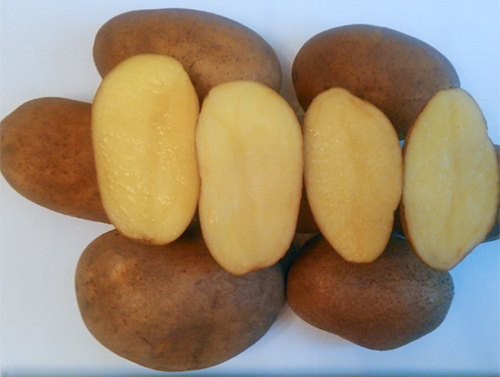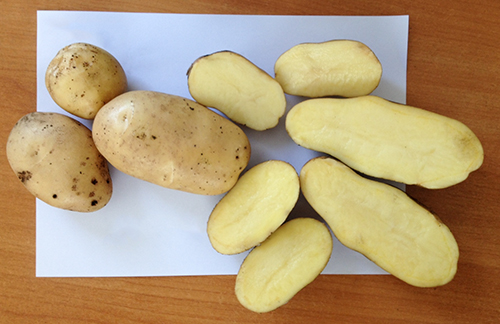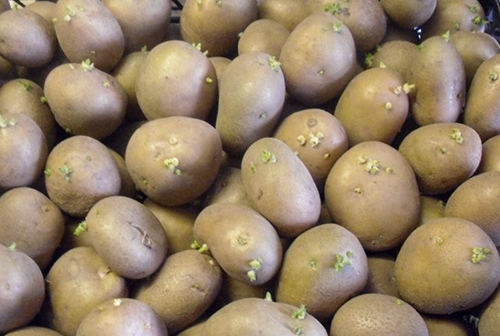Potato variety Scarb
Scarb is a medium-ripening potato variety (Solanum tuberosum). One of the most popular varieties of Belarusian selection. In Belarus, this variety accounts for about 30% of all plantings. Bred by the staff of the Scientific and Practical Center of the National Academy of Sciences of Belarus for potato and horticultural production. In 1997 it was added to the state register of varieties of the Republic of Belarus in all regions. In 2002, it was added to the state register of varieties of the Russian Federation in four regions: Central, North-West, Volgo-Vyatka and Ural. The authorship is assigned to Z.A. Semenova, A.N. Dorozhok, E.G. Ryndina, N.P. Yashchenko, V.V. Dedyulei, L.I. Pishchenko, A.E. Zuikov and L.V. Illegal.

Plants are semi-spreading, medium-sized, semi-erect. The leaves are open, medium-sized, dark green in color. The leaves are medium in size. The waviness of the edge is very weak or absent. The flowers are white, medium-sized.
Tubers are large, aligned, rounded-oval and oval, compactly located in the nest; there are from 10 to 14 of them on the bush. The eyes are very small and superficial. The skin is yellow, smooth, firm. The pulp is yellow.
The mass of the marketable tuber is 94 - 138 grams. The yield of commercial tubers is 250 - 410 c / ha, which is at the level of the Petersburg standard and 105 c / ha higher than that of the Bronnitsky standard. The maximum yield recorded in the Vologda Oblast is 508 c / ha, which is 133 c / ha higher than that of the Petersburg standard. The yield declared by the manufacturer is up to 630 c / ha. Marketability - 84 - 99%, which is at the level of Golubizna and Bronnitsky standards.
A table variety, belongs to culinary type B (slightly boiled; tubers become crumbly only after prolonged cooking). Suitable for preparing salads, chips, frozen vegetable mixtures, fries liquefied with food additives, and also proved to be good for frying. Possesses satisfactory and good taste. It is convenient to clean the tubers. The starch content is 10.8 - 17.7%, which is 0.9 - 1.5% lower than that of the Petersburg and Golubizna standards.

Scarb is resistant to the causative agent of potato cancer and golden potato cyst nematode, as well as to wrinkled and banded mosaics. Has a relatively high resistance to blackleg and wet rot. However, it is susceptible to the causative agent of late blight of tubers and leaves. Medium drought tolerant. At the initial stages of growth, it is sensitive to waterlogging of the soil (even short-term). Viral diseases and common scab are slightly affected.
These potatoes keep well due to the long period of physiological rest, which is 115 - 120 days. Even in September, last year's harvest remains vigorous. Keeping quality - 88 - 99%.
Scarb rises slowly and unevenly. But during the growing season, the crops are leveled and quickly grow tops. Flowering is also unfriendly.
Before planting, it is necessary to warm up and germinate the tubers. Due to the long dormant period, it takes a long time to warm up the tubers of this variety - within 2 - 3 weeks. The tubers are planted shallowly, and after the seedlings grow up, high hilling is carried out. Any type of soil is suitable for planting, but this variety gives the best result on sandy and sandy loam soils with a minimum planting depth (loves spring warmth). Plants effectively use natural fertility and respond well to mineral fertilizers. For the development of the root system, phosphorus fertilization is highly desirable.

Advantages of Scarb potatoes: high and stable yield, excellent keeping quality and marketability, resistance to nematodes and viral diseases, uniformity of tubers.
Disadvantages: only average taste, watery tubers, susceptibility to late blight. Also, according to gardeners' reviews, starting from the third reproduction, the yield of Scarb drops dramatically.
Many Internet sources mention that the tubers of this potato cannot be cut before planting.However, some growers using this method have achieved positive results when growing this variety. As a rule, the result depends on the type of soil, the method of preparation of the planting material, the cultivation technology and weather conditions.
Also, it should be noted that due to the fact that Scarb is afraid of spring waterlogging of the soil, it is better to overexpose it during germination than to plant it in moist and insufficiently heated soil.









Delicious potatoes !!! No wonder belongings from a Belarusian treasure or treasure! One of the best in taste! Plant, you will not regret ...
The potatoes are very tasty, but, unfortunately, very susceptible to late blight, this year they hit the entire crop (((
This year, late blight has affected all potatoes. Except for Sineglazka.
I can't remember how many years I have been planting this potato variety. Long. I appreciate it for keeping quality. I have a good cellar, but that's not the point. Store-bought potatoes are also stored in the same cellar, which by March is already sluggish and wrinkled. But Scarb remains strong until June. I don't know further - we eat it because. Over time, its yield really decreases, I know from my own experience. But, again, from experience - you need to change the place and apply fertilizers. I bring in both organic and mineral. To save money - directly into the hole during planting. Then again, before hilling - mineral under each bush (I have a small area under the potatoes). And for such attention - a good harvest!
For 15 years Skarb has been pleasing our family with productivity and taste. Yes, the germination is not the same, but the keeping quality is excellent, it is afraid of phytophthora, it is necessary to spray it with drugs. And in order not to appear, pay attention to the selection of seeds, they should be almost perfect.